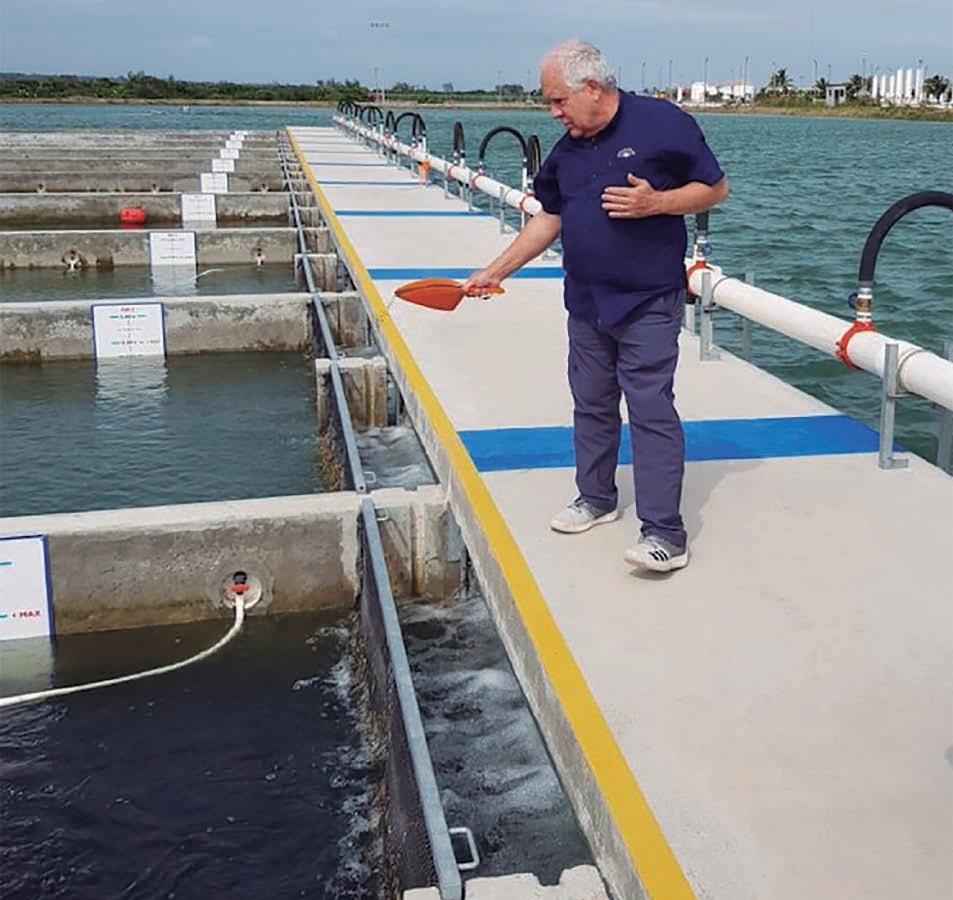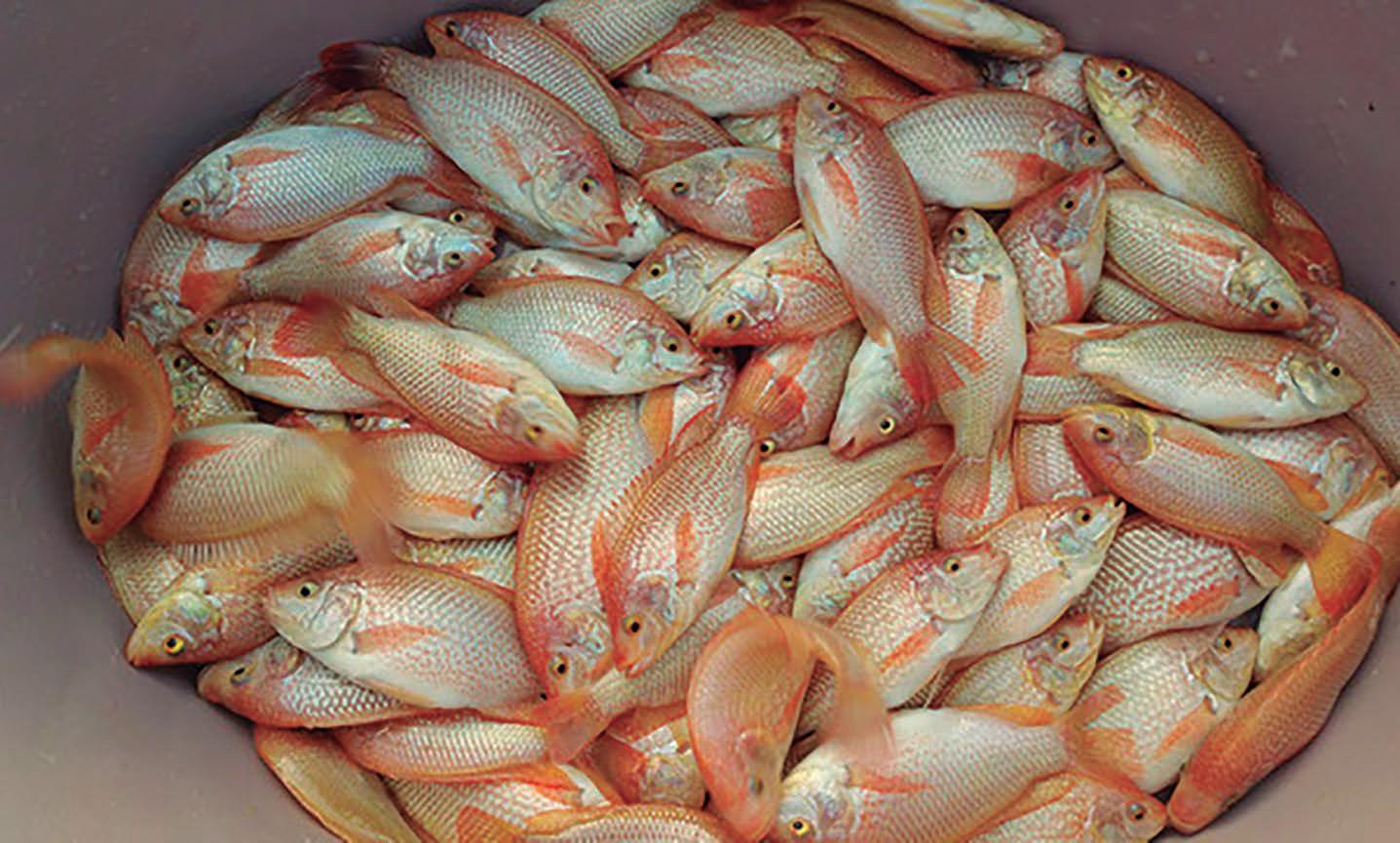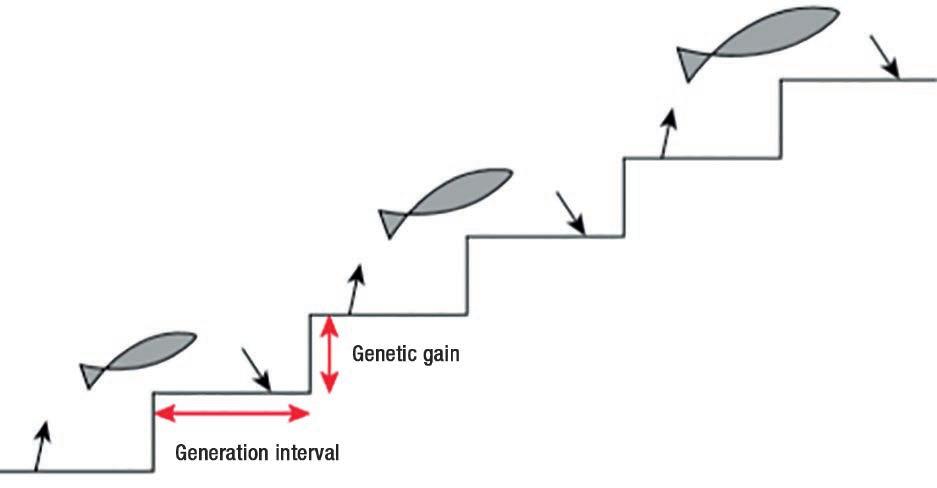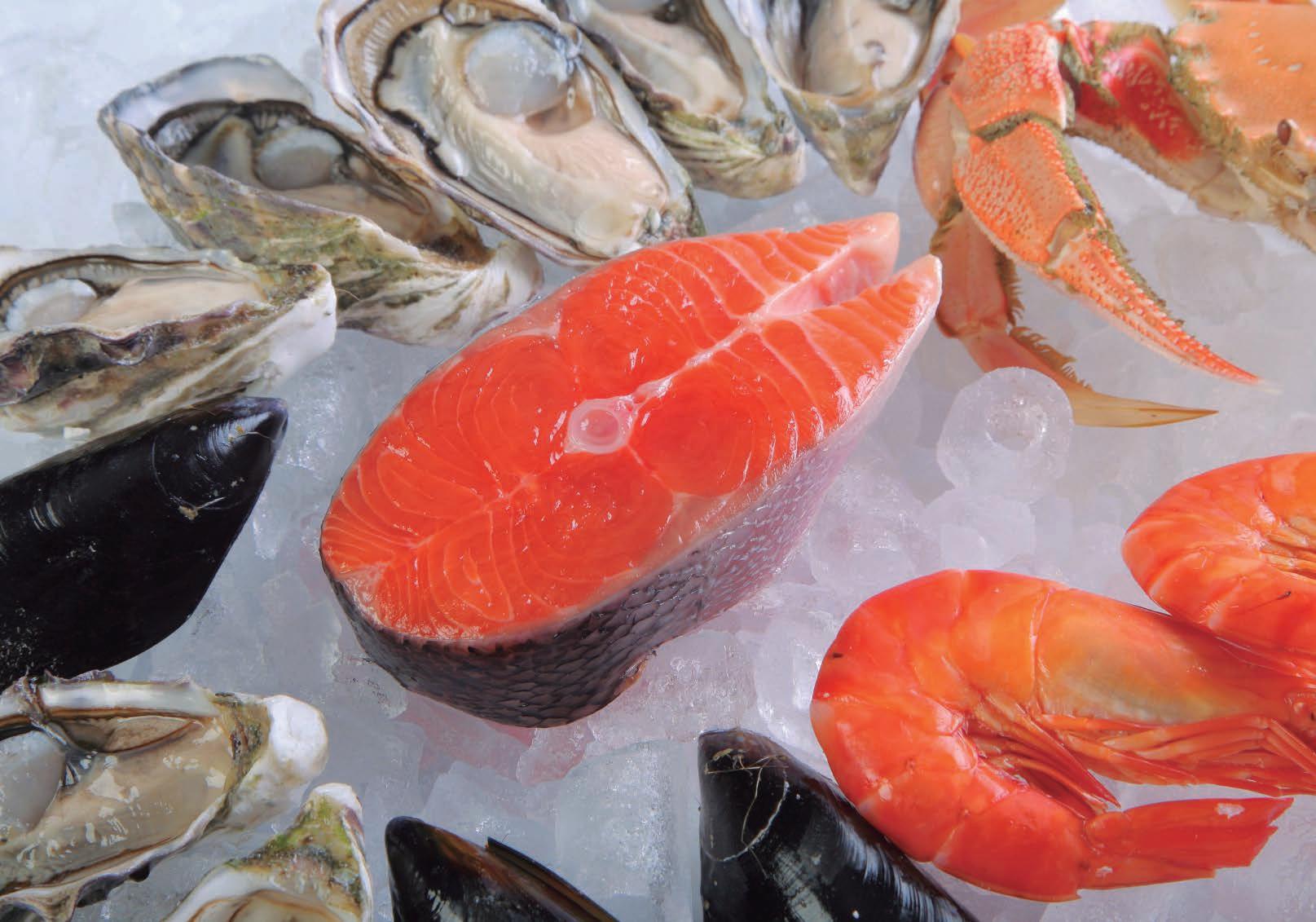
12 minute read
Genetic Variation in Disease Resistance Against White Spot Syndrome Virus (WSSV) in Litopenaeus vannamei

By: Trinh Thi Trang, Nguyen Huu Hung, Nguyen Huu Ninh, Wayne Knibb and Nguyen Hong Nguyen*
Litopenaeus vannamei is the main species for the shrimp aquaculture sector due to its advantageous biological features and the availability of genetically improved shrimp lines. Nevertheless, in recent years viral diseases such as Taura syndrome virus (TSV), white spot syndrome virus (WSSV) and yellow head virus have caused significant economic losses for the shrimp sector.
WSSV is one of the most adverse pathogens in shrimp farming. The infection of WSSV on whiteleg shrimp is characterized by rapid mortality, up to 100% within 7–10 days. In growout culture, shrimp at all ages and sizes are sensitive to WSSV. The highest mortality rate is usually recorded 1–2 months after stocking. To date, measures to control WSSV include improving environmental rearing conditions and management practices or using specialized formulated diets to boost shrimps’ immune systems, as well using ‘vaccines.’ However, none of these methods are cost-effective and practically feasible. Therefore, the development of highly WSSV resistant lines of L. vannamei through conventional selective breeding approaches has been initiated as the first step in a long-term genetic improvement program for this species to promote sustainable development of the shrimp sector world-wide.
The aims of this study were to estimate the heritability for WSSV resistance and its genetic correlations with body weights during the early juvenile stage and at harvest. Additionally, the study analyzed WSSV titer to understand pathogenic differences between high and low WSSV resis tant families.
Materials and Methods
Shrimp used in this study originated from the third generation of a Whiteleg shrimp population selected for high growth. The founder population included eight stocks from Mexico, Ecuador, Colombia, United States of Amer ica (three populations), Thailand, and Indonesia. In 2014, a partial diallel cross was carried out to form a base popula tion (G0) for selection. Selection for growth was practiced from 2015 through 2017. In 2017, a total of 150 full- and half-sib families were produced, from which 200 represen tatives of each family were randomly sampled for this study.

When shrimp reached an average size of 2 g at about 50– 70 days post-hatching, they were collected for PCR screening for four pathogens (IHHNV, YHV, TSV, and AHPNV) to ensure that they were disease-free for tagging. A total of 200 shrimp per family were then tagged on family level basis using Visible Implant Elastomers, VIE (Northwest Marine Technology). Two different colored tags among five color options (red, orange, green, yellow, and pink) were inserted at the first left and sixth right abdominal segments. Totally 30,000 shrimp from 150 families were tagged and measured for body weight and length. A total of 15,000 shrimp (100 individuals per family × 150 families) were used for challenge test experiments and the other half (15,000 individuals) were kept in bio-secure rearing systems as a back-up population.

Shrimp diagnosed with WSSV infection were collected from grow out shrimp ponds in Ben Tre province, Vietnam and confirmed by PCR/ RT-PCR for WSSV infection and other pathogenic absence. Preparation for virus aliquots was made as follows: the exoskeleton (5 g) of a frozen, naturally diseased Whiteleg shrimp that had positive WSSV diagnostic was extracted with 10 ml PBS (8 g NaCl, 0.2 g KCl, 1.44 g Na2HPO4, 0.24 g K2HPO4, pH adjusted to 7.4, and dH2O added to 1 L) supplemented by a vigorous vortex and centrifuged at 3000 rpm for 10 min at 4ºC. The supernatant was filtered through a 0.45 µm membrane. Number of viral copies (or viral titer, viral load) was quantified using quantitative real-time PCR (qPCR).
Figure 1
Survival trend over 15 days period after the challenge test in the highest and lowest resistance families.


Figure 2

Survival trend over 15 days period after the challenge test in the highest and lowest resistance families.
The challenge test was carried out by communal rearing of families in five 10 m 3 tanks in two replicates (10 individuals/family × 150 families per tank in each replicate) over a 15-day experimental period. Water-borne infection was applied by placing shrimp in WSSV-infected water containing viral copy concentration of 2 × 10 4 WSSV copies/ml in the first day and then the shrimp were moved to a new tank which contained uninfected filtered seawater for the remaining experimental period. The experimental shrimp were fed with a commercial diet containing 40% protein, three times a day.
To understand pathogenic differences between the high- and lowresistance families (mean survival = 49.5 vs. 30.1%, respectively), WSSV titer was analyzed using quantitativereal time PCR (qPCR). The moribund shrimp from the challenge test were collected and stored in Ethanol 70o. DNA from five moribund shrimp from each family (10 mg pleopods per each sample) were extracted with a Qiagen Dneasy Kit. DNA concentration was measured by spectrophotometer at a measuring length of 260 nm. Quantification of WSSV viral copy number in infected shrimp samples was conducted on family pool samples, using qPCR protocols.

Table 2

Number of observations (n), mean, standard deviation, minimum, and maximum survivals over six different experimental periods.
Table 3
Heritability (h 2 ± s.e.) for WSSV resistance, and h 2 and common full-sib effects (c 2 ± s.e.) for body traits.

Phenotypic (above) and genetic (below the diagonal) correlation among survival traits.
Table 4

Dead and moribund shrimp were collected every hour during the challenge test in the first three days. Subsequently, the number of dead/ moribund shrimp was recorded three times a day until the experiment was completed. Data recording was stopped when the population showed 50% mortality, at about 15 days of artificial post-test. In this study, WSSV resistance was measured as survival rate at different experimental periods. Survival traits in the challenge experiment were treated as binary variables in which dead shrimp were designated as zero, and live animals at the end of the test were assigned a number one. The survival data were calculated for six different times during the challenge experiment, from the commencement of the test to day 3, 5, 7, 9, 12, and 15 (S1, S2, S3, S4, S5, and S6, respectively). Preliminary analysis using the general linear model was first used to calculate basic statistics and identify survival trends in the high- and low resistance families, using SPSS v.24. The viral copy number in infected shrimp samples was calculated by using qPCR and analyzed on software Rotor-Gene 2.1.0.9. Pathogenic differences as measured by the viral copy number (or viral load/ viral titer) between the high and low resistance families were examined using Kaplan– Meier estimator (SPSS v.24).
To estimate the heritability for WSSV resistance, two different approaches were used (1) a linear mixed model (LMM) and (2) a threshold logistic generalized mixed model (TLGM) in ASREML 3.0 software. The initial LMM model included the random effects of the additive genetics of individual shrimp and the common full-sib groups (c 2 ) together with all possible fixed effects of spawning time and age from birth to the challenge test. The effect of spawning time was not statistically significant (P > 0.05) and not included in the final model. Logarithmic Likelihood Ratio Test (LRT) indicated that the random effects of common full-sib groups were not significant for WSSV resistance. Nevertheless, it was also included in the model to avoid any possible bias in genetic parameter estimates.
Results
Shrimp artificially infected with WSSV showed typical clinical signs of white spot syndrome disease. After 48 h infection, the tested shrimp showed apathetic behavior near the tank edge, slow movement, dis-orientation and body discoloration. The first deaths were recorded on the third day of infection. There was a significant difference (P < 0.001) in WSSV viral load between the high resistant and low resistant families (Table 1). The amount of viral load was significantly lower in high than low resistant shrimp families, suggesting that resistance mechanism in shrimp was likely to diminish viral transmission and proliferation in the high resistant families.

In the challenge test period of 15 days, the mean survival rate of 150 full- and half-sib families was 42.8%, ranging from 16 to 50% (Table 2). Based on the analysis of three successive intervals, the lowest survival rate was about 84.6% in the period of day 3 and 5, while the highest value of 94.5% was observed during days 7–9. For growth traits (body weight and length) that were measured on individually tested shrimp prior to the experiment, the mean value was 2.2 ± 0.31 g and 63.5 ± 2.9 mm, respectively, after 15 days (Table 2). After 50 days of grow-out in biosecure systems, the siblings reached 24.0 ± 5.64 g at the time of harvest in December 2017. There was significant variation (P < 0.001) in WSSV resistance among 150 challenged shrimp families over the entire experimental period (Figure 1). The greatest variation in the survival rate was observed in the period of day 9 and 12 (from 60 to 97%). A similar trend was also observed for S1–S5 (P < 0.05– 0.01). For example, the survival rate ranged from 64 to 100% for S1. The survival trend also differed significantly (Kaplan–Meier estimator and log-rank test, P < 0.001) between the highest and lowest resistant families (Figure 2). In both groups, mortality did not occur in the first 2 days. After the challenge test, mortality occurred earlier and at a faster rate in the low than high resistance families.
Heritability was estimated from two different statistical models: LMM (model 1) and logistic threshold mixed model (model 2). Across the models, heritability for WSSV resistance in this shrimp population was moderate in the early experimental periods (S1–S4), while a low h 2 estimate was observed 12 and 15 days after the challenge test (Table 3). The value of heritability estimated for day 12th and 15th from both models were close to zero (the h 2 = 0.06 ± 0.02 and 0.01 ± 0.01, respectively). The common full-sib effect (c 2 ) based on logarithmic LRT was not significant for WSSV resistance in this study. The LogL value did not change when the full or reduced model was used. The c 2 effect explained less than 3% of total variance for WSSV resistance and only 2% of the total variance for body traits in this population (Table 3). The estimates of phenotypic and genetic correlations between survival traits are shown in Table 4. The phenotypic correlations ranged from 0.31 ± 0.01 to 0.85 ± 0.01. The genetic correlations were high and approaching one (0.80 ± 0.05–0.97 ± 0.01). Both phenotypic and genetic correlations between successive challenge phases were greater than those that were further apart. As described above, all the survival traits examined here included mortality of previous periods and hence, the phenotypic and genetic correlations should be interpreted in this context.


The heritability estimates for survival rate in the first three measurements were higher than those obtained in the later periods (0.36–0.20 for 3 days, 5 days vs. 0.04–0.14 for 9, 12, and 15 days). This decelerating trend of heritability was also observed when statistical analysis was conducted separately for six different time intervals from day 1 to 3 (S1–3), 3–5 (S3–5) and 12–15 (S12–15). Earlier studies reported heritability for WSSV resistance during a grow-out phase in Whiteleg shrimp. One study showed that the heritability for WSSV resistance to a natural disease outbreak in L. vannamei reared in ponds to harvestable size was low (0.06 and 0.02), and a similar estimate was obtained in a different shrimp population. In other reports the heritability for WSSV resistance in adult shrimp populations was low (<10%). The higher estimate of heritability for WSSV resistance in our study especially during the first five days of infection than the published information can be explained because our experiment was carried out during the juvenile rearing stage.
Collectively, it is suggested that selection for high growth may not have detrimental effect on disease risk of the population. Selection for high growth will reduce production time and hence, reducing exposure to the pathogen and risk of infection. However, when more data is accumulated, further analysis should be conducted to confirm the genetic correlations between WSSV resistance and body weights in this population of L. vannamei. WSSV resistance was heritable in this population of L. vannamei, suggesting that genetic improvement in WSSV resistance can be achieved via selective breeding.
Due to a single generation data records for traits examined here, continuing collection of more data is needed to better understand genetic relationships between body weight, viral titer and WSSV resistance in the present population of Whiteleg shrimp. Examination of the effect of genotype by environment interaction on these traits also merits further study to assist the design and conduct of genetic improvement programs for L. vannamei.
Trinh Thi Trang 1,2 *, Nguyen Huu Hung 3 , Nguyen Huu Ninh 3 , Wayne Knibb 2 and Nguyen Hong Nguyen 2 * 1 Faculty of Science, Health, Education and engineering, GeneCology Research Centre, University of the Sunshine Coast, Maroochydore, QLD, Australia; 2 Vietnam National University of Agriculture, Gia Lâm, Vietnam; 3 Research Institute for Aquaculture No. 3, Nha Trang, Vietnam. Adapted (https://creativecommons.org/licenses/by/4.0/) from Frontiers in Genetics, doi: 10.3389/fgene.2019.00264, © the authors. This is an informative version of the original article made by the PAM editorial staff.








